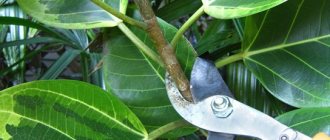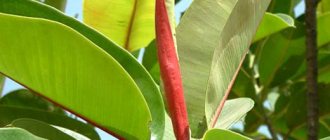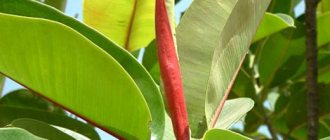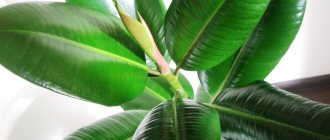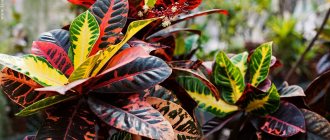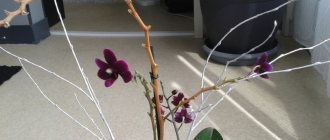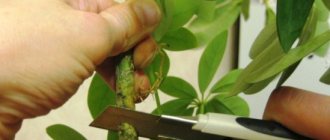Directory of indoor plants
Perfectionists will understand me - the cheflera grows quickly, but something always happens, and it begins to stop at some stage or become distorted.
I personally don’t like it when my shefflera turns from a straight plant into some kind of twisted stalk, so I fight with it until my persistent methods defeat the stubbornness of the shefflera. Trimming the top of the shefflera is already a common thing in monthly care. I try not to repeat pruning often, because the plant weakens a little after it. I often use the tip in the method of cutting Schefflera with apical shoots, which I safely place in water, and then wait for the first roots to be transplanted into a special simple and loose substrate for further development.
I cut the tops large enough, so that after trimming the cheflera it becomes much shorter than it was. I don’t know if it’s right to cut off 20 centimeters from the top at once, but the plant then grows like a wild one. I use this technique when the cheflera begins to slow down in his development. Since the cutting that was cut was adjacent to the main stem of the sheflera plant, a few weeks later a new thin arrow appears in the same cut place, which is already beginning to produce leaves.
You can almost simultaneously trace the tendency of germination of Schefflera cuttings that were cut and new branches from the main stem of the plant from the place from which the cut was made. One day my cheflera actually started to rot. I had to cut everything down to an even line and throw away the entire top. I don’t think it was so fatal for the sheflera, because mine is still alive. Trimming the top is still a very pleasant and effective way, at least for the owner, when the plant no longer fits on the windowsill, and why not the entire distance from the floor to the ceiling. I don’t advise the chefler to let it grow to such a size, because then it will be a pity to cut it off, you will crumple at first, put it off until tomorrow and admire it. But it is necessary to trim the top, because then the cheflera will slow down its growth and cease to please, and such a large plant needs to be placed somewhere.
To walk you through the process itself, I’ll explain how to carry it out. Take a pruner, wipe it, and cut off the apical shoot of the sheflera right under the main trunk. Cover the cutting area with something if the plant is dense and large, and if it is young, it will heal successfully on its own. The cuttings can be processed, the leaves can be cut off from the bottom, the stem can be cleaned a little and rooted, or you can simply throw them away. After this, feed the adult sheflera plant, give it water and make sure that parasites do not attach themselves. The same is true for cuttings - they are weakened and will not be very comfortable at first, so they are very vulnerable to disease. They need to be kept in partial shade in water for the first time, and when they take root, they should be kept in the soil substrate and on the windowsill, next to the mother plant. Make sure that if the adult plant from which you cut it was sick, then in no case should you place young cuttings nearby, and after placing them in the soil, immediately prevent that disease, virus or parasite. which was picked up by an adult cheflera - this way you will save the cutting from a possible disease.
Please rate the material you read :)
The charming umbrella tree in the wild is represented by more than 200 species, of which several especially decorative ones are grown at home. The pruning of sheffler, which is demanding in terms of growing conditions, is no less important than watering and fertilizing, and is loved by flower growers for its unusual beauty.
History of flower cultivation and signs
There is no consensus on who the umbrella tree was named after. According to one version - in honor of the German botanist J.K. Schaeffer, who made a huge contribution not only to the study of plants, publishing a book on plants in medicine in 1759, but also left a mark on religion, optics and other sciences. According to another version - in honor of the scientist P.E.Ya. Scheffler from Poland. Both lived in the 18th century.
The tree-like plant has earned popularity among esotericists for its ability to absorb negative energy. It’s good to place it in the bedroom, to improve the energy background, or in crowded places. For example, offices or meeting rooms.
The flower is also endowed with the gift of prediction. It is worth observing the behavior of an indoor psychic to understand in what area to expect changes:
- falling leaves warns of illness of someone living in the room;
- darkening of the trunk warns that the atmosphere in the house is too negative and the plant can no longer cope with cleansing;
- lack of growth portends a period of stagnation in some area of life;
- but a jump in growth and lush flowering brings good news about a new addition to the family.
Scheffler's home flower, description
Schefflera (Araliaceae family) pleases with a variety of natural forms - tree, bush, liana. Particularly interesting are the leaves, similar to wide-open palms, colored in emerald green; some varieties have a variegated color. They are especially popular. Types suitable for home floriculture:
- radiate leaf (Shefflera actinophylla);
- eight-leaved (octopus, Sh. Octophyla);
- tree (Sh. Arboricola);
- palmate (Sh. Digitata);
- most graceful (Sh. Elegantissima);
- Veitch (Shefflera veitchii).
Types of pruning Kalanchoe
There are several stages in this process and each of them has different goals.
It’s worth paying attention to this, because both the appearance of the plant and its health depend on timely and competent pruning and formation of the bush.
Forming a bush correctly
This procedure has its own subtleties that should be studied in more detail.
- Before you start pruning, you need to know exactly the varietal identity of the plant. The features of crown formation also depend on this.
- If you have just recently purchased a flower, then you should not start pruning right away. The plant must take root in its new location. Take a break.
- In winter, when Kalanchoe is dormant, pruning is not recommended.
- All instruments must be disinfected before and after procedures to avoid infection. The knife, pruning shears or scissors must be sharp.
- If you manually pick off the leaves and inflorescences, the Kalanchoe may begin to fade.
- It is recommended to carry out the pruning procedure either in the morning or in the evening. During this period, try to place the pot with the bush in a place where the sun's rays do not fall on it.
- When you have trimmed, the cut areas should be immediately sprinkled with crushed charcoal or activated carbon.
- If the flower has just been transplanted, wait a few weeks to prune it so that the plant can take root and adapt.
- When you see that a bush is suffering from an invasion of pests, then only after they have been completely destroyed is it worth pruning.
First trim
It is carried out for preventive purposes. The most suitable period for this procedure is spring. Here's what you need to know.
- When the flower wakes up, after 30 days the first pruning should be done. At this stage, several leaves at the tops of the shoots are removed.
- After the procedure, it is not recommended to place the bush on the south or southeast side of the room so that it does not begin to grow too actively. The appearance of the Kalanchoe will then quickly lose its neatness.
Sample for preventive purposes
As the plant grows quite actively, this type of pruning is relevant. There are several reasons why this procedure is necessary.
- In places where shoots and leaves were previously cut off, new shoots begin to form in the axils and buds. It is also necessary to remove several leaves from them so that the crown remains formed according to your idea.
- Inspect the plant regularly and remove all dry or rotten parts immediately, then the Kalanchoe will be healthy and you don’t have to be afraid of the appearance of various rots.
- The lower shoots of the bush gradually shed their leaves and become bare. The view is unattractive. Therefore, the recommendation is this: as the flower grows, remove the bare lower branches. In this case, only fresh and juicy green young foliage will remain.
- In summer, the upper shoots begin to stretch out very actively. In order for the laterals to grow and the shape of the bush to be lush, the tops should be pinched.
If the top shoots have grown to 10 - 12 cm, then they can safely be used for propagation. This is very simple and does not require any effort - placed in water at room temperature, the leaves and cuttings sprout roots after a while. You can plant a young plant in the ground.
What to do after flowering
The active flowering period of this decorative flower begins at the end of winter and continues into the spring months. The specificity of the development of Kalanchoe is such that peduncles are formed precisely at a time when daylight hours are short.
- In the case when the second half of the spring period has already begun, but flowering does not occur, then 3 - 4 upper leaves on each shoot are pruned - this procedure will force the bush to develop flower stalks more actively.
- There is no need to wait for all the branches to dry out and all the petals to fall off after flowering. Prune as soon as you see the flowering has finished. Then, at the cut site, young branches with leaves and new buds will immediately begin to form. It is better to remove faded shoots at the root to prevent the entire plant from drying out.
- After pruning the Kalanchoe after the flowering period is completed, it is necessary to give it time to rest and rest. To do this, place the flower in a dark and cool place where there is no sun and the air temperature does not exceed + 15 - 17 degrees Celsius. At this time, you need to water very little - only once every 20 days.
Forming a tropicana correctly
Lovers of indoor gardens are often lost when it comes to pruning exotic plants. The procedure can often cause harm. Let's deal with everything in order.
Is it possible to prune Schefflera?
First of all, you need to remember that the event significantly reduces the decorative effect. Therefore, flower growers often do without it. The degree of importance of shortening the sheffler is determined by the species or varietal:
- Radiant-leaved species, which have a single stem, are allowed to grow without intervention.
- Tree-like branches are shortened as they grow, which saves space.
Why does Schefflera need pruning?
Exotic grows quickly, but sometimes growth slows down catastrophically for no reason. It happens that a plant, or rather its stems, begin to bend on their own, taking on a shape that does not closely correspond to the owner’s intentions.
To stimulate the normal growth of the tropical guest, part of the shoot is removed. They do the same thing to form a lush crown - it rarely shows the ability to branch without external influence. And maintaining a neat shape without “surgical intervention” is simply impossible.
When is the best time to prune an umbrella tree?
The optimal time for formation is the beginning of spring, still during dormancy, but awakening is about to begin.
Trimming tools
By the end of the season, young shoots become woody and the bark becomes dense. A sharpened garden pruner is considered the best tool; a kitchen pruner is suitable if the shoots are thin. Important condition! The tool must be disinfected before starting work.
Pests and diseases
Every plant gets sick from time to time
In this case, it is very important to quickly and correctly determine the cause of the disease - most likely, it is due to improper care or pests. The main diseases of Schefflera:
Schefflera leaves turn yellow
Usually, sheflera leaves turn yellow due to insufficient lighting. In this case, the plant must be placed closer to the light source, but the leaves should not be exposed to direct sunlight - this may cause white spots to appear on them.
Another possible cause of yellow leaves is pests. Most often, the chefler is struck by:
- spider mite;
- scale insects;
- aphid;
If the plant is affected by pests, its growth slows down, the leaves lose their bright color, and eventually the shefflera dies.
The presence of a spider mite can be easily determined by the presence of the finest cobwebs on the plant. At the initial stage, it is enough to simply wipe the plant with a soapy solution, but in case of severe damage, you will have to use an insecticide.
After wiping with soapy water, you must apply Karbofos or Actellik (15 drops per 1 liter of water)
It is very important to carefully ensure that insecticides do not get into the soil. If necessary, these drugs can be used again after 12-14 days
When aphids appear, you must first clean the plant from it using a napkin or sponge soaked in a soap solution, and then treat it with an insecticide.
If a plant is attacked by a scale insect, then you must first destroy the insects, since they are well protected from the effects of chemicals, wash the plant with a soapy solution, then apply the appropriate preparation.
Schefflera leaves are darkening
Sometimes sheflera leaves begin to darken at the tips. The most obvious reason is insufficient air humidity, poor or infrequent watering. It is necessary to adjust watering and spray the plant with a spray bottle more often. Schefflera is a moisture-loving plant, so it is useful to sometimes give the plant a shower (no more than 3-4 times a year)
In this case, it is necessary to pay attention to ensure that the water pressure is not too strong and does not damage the young shoots.
Schefflera sheds its leaves
Why does shefflera shed its leaves? There are two main reasons for this leaf fall. Either the room temperature drops below 12 degrees or rises above 30, or the reason is an excess of moisture. If watered too much, the roots of the shefflera may rot and the plant must be helped immediately.
First you need to carefully remove the plant from the pot and inspect the root system. If areas affected by rot are found, you must carefully remove them, and then dip the roots in a solution of Epin or Zircon and leave for an hour and a half
After this, treat the shefflera with Fitosporin (you can sprinkle it with wood ash) and transplant it into a pot with new soil. For a week after transplantation, you need to keep the plant in a “greenhouse” - covered with a transparent bag or plastic wrap.
Schefflera can also suffer from drafts. This may also be the cause of leaf shedding. In this case, you just need to choose a more suitable place for the plant.
Sheflera is very popular not only among experienced, but even novice flower growers for its unpretentiousness. Caring for a cheflera can be done even by those who have never cared for plants.
And more advanced ones can try to give the plant the desired shape - for example, braid still young stems into a braid, or give any other shape by trimming excess branches. With proper care, cheflers will delight their owners for a long time and will decorate any interior.
Forming an umbrella tree at home
They form a flower according to their wishes: a slender tree with a fluffy crown, a branched tree, a bush, weave trunks, etc.
How to trim the top correctly
Pinching the tip is usually necessary to force the plant to produce side branches. A peculiarity of all shefflers is that the axillary buds sleep until they receive a stimulus to awaken - the removal of the upper part of the trunk.
If you cut 1-2 leaves from the top, the upper eyes will wake up and growth will resume only upwards. Therefore, the crown is removed, counting out at least 5-6 petioles, and several equivalent buds are obtained that are capable of producing side shoots.
There is an interesting way to force a wayward tropical tree to branch: the tree is carefully bent down and fixed. After some time, the eye located above the rest will wake up and begin to grow. The cut part is usually rooted, i.e. used for reproduction.
Schefflera leaves are turning yellow, what should I do?
The crop needs feeding, every week, starting in spring.
It is worth alternating fertilizing, one week adding nitrogen and complex preparations for indoor crops, and the next time adding organic ones. In winter, the flower does not need fertilizer. During this period, the amount of moisture is reduced and fertilizers are not applied. It is recommended to reduce the temperature to give the culture rest. Each owner of a houseplant independently decides when to fertilize and prune. Experts recommend trimming the top. After it, side leaves and branches will begin to grow. The plant will become more lush and voluminous. Leaves cut from the top can be placed in water and rooted. This will allow you to grow additional seedlings. Based on the condition of the leaves, you can determine what the flower is missing.
Schefflera leaves turn yellow, what to do:
- If they darken at the tips, the crop does not have enough fertilizer.
- If the leaves dry out at the tips, it means the plant does not have enough moisture.
- If darkening is observed at the tips, stop watering. This indicates an excess of moisture.
- Yellowing of the crown indicates a deficiency of minerals and stagnation of moisture.
Fruit
How to form a crown
Before taking the pruning shears, the gardener must decide what he wants his green friend to look like: a spreading bush, a slender tree, an exquisite bonsai.
Forming a tree
First, wait until the flower reaches the desired height plus 5-6 leaves. Then the top is cut off. Since cases when all the buds wake up are extremely rare, experienced gardeners advise using the technique that gardeners resort to when forming the crown of fruit trees: the bark is cut above the eye at a height of about 1 cm. At the same time, the flower behaves like an apple tree, immediately responding with young shoots.
Sanitary pruning of plants
Sanitary pruning of barberry is carried out annually. In the process, you can also begin to form a crown. It is recommended to trim only healthy shoots, but do not be too zealous. Weak branches are removed completely.
The crown can be formed only in the second year of the plant’s life. In this case, it is worth familiarizing yourself with the diagram in order to make the correct haircut and not damage the flower. The procedure should be carried out in the spring, before the buds bloom, and before winter, when the harvest has already been harvested.
Next spring it is recommended to shorten the shoots to 10 cm above the ground. The procedure will increase the density of the bush, it will begin to branch. At the 3rd year of life, 15 cm of shoots are left above the soil level. For a single plant, this method of cutting barberry will allow it to be kept in a ball shape for a long time. Border plantings and hedges require this procedure.
Scheme of sanitary pruning of barberry
Ways to braid a shefflera
You can get a beautiful crown by planting several sprouts together, preferably vines - their trunks are more flexible:
- Double helix. A support is installed between two young shoots and the stems are wrapped around it. Carefully secure it at the top with a clamp, leaving a gap so as not to damage the stems.
- Pigtail. Braid from 3-4 young plants, also using support.
- Lattice weave. A flower lattice-support is installed next to 2-4 sprouts, they are entwined with flexible shoots, guiding them randomly.
Planting and care
Many people grow Schefflera indoors; it is unpretentious. It grows quickly and as a result grows into a beautiful plant with leaves blooming in different directions. For planting, the soil must be selected. It should be low acidity and light. The soil is purchased in specialized stores or prepared independently. There are two popular and available options:
Soil for palm trees also contains beneficial components. On sale you can find special soil for all varieties. At home, the Schefflera flower does not require special care; it is enough to care for it according to the following rules:
- The presence of high air humidity in the room is most suitable for bushes, but at the same time, they are not afraid of indoor conditions. However, the leaves are regularly sprayed with settled water at room temperature.
- Schefflera loves light, but direct exposure to sunlight is unacceptable for him. In summer, take it out into the fresh air, placing it in partial shade.
- The flower is watered once every two days. When watering, it is especially recommended to use soft, settled water at room temperature, while monitoring the soil. It should have the consistency of a wet, sticky lump. In winter, watering is done less frequently.
- The tree is placed in a place that is spacious for its growth, taking into account the amount of light. Drafts and close proximity of heating devices are contraindicated for plants.
- Fertilize once a year, in March or October. 200 g of ash per bucket of water, mix thoroughly and water with this solution once every 2 weeks.
- The soil of young Schefflera is changed annually, in spring or autumn. For an older plant, this procedure is carried out when the ground at the planting site is entwined with roots. The pot for replanting is taken with a diameter 2-3 cm larger than the previous one, the type of soil is the same as that used for planting.
- The optimal temperature for the flower is +17-+20 °C. When a given elevation rises or falls, the foliage falls off.
- Since the plant reacts negatively to pruning, this procedure is best neglected. To add splendor, 3-4 seedlings are grown in 1 pot. As a last resort, pruning is carried out at the base, cutting off the lower branches.
During the dormant period, Schefflera stops its growth. At this stage, which begins at the end of November and ends in March, the air temperature is reduced to +16-+18 °C and watering is reduced to a minimum.
When is the best time to prune?
Like any other manipulations with plants, pruning should be done in the spring. Most often this is March–April, the time when the plant wakes up from hibernation and all life processes resume.
It is not worth trimming bushes at other times of the year. In the fall, they prepare for hibernation and may not recover (or not fully recover) after the procedure. In winter, when the plants enter a dormant period, there is no need to touch them at all. They rest and gain strength for the new season.
The optimal time for any operations is spring.
Rested, with a supply of fresh strength and juices, the plants feel great and endure all procedures with vigor.
Schefflera in the house - signs
Some people whose apartment is decorated with a flower claim that after its appearance their lives changed for the better. Such statements have become the basis of numerous superstitions and signs:
1. An exotic plant takes away negative energy, thereby normalizing the atmosphere in the house. You can even get rid of fatigue if you sit near the cheflera after a hard day at work.
2. The flower has magical properties that can strengthen and increase well-being. It strengthens the team and increases productivity. Businessmen are advised to place a pot of sheflera in their office. This will help improve the success of the enterprise and attract new customers.
3. The umbrella plant creates a favorable climate around itself and humidifies the air. If you put it in the bedroom, you can forget about insomnia. Will improve the flower and the relationship between lovers.
4. Located in the children's room, the cheflera will help the child concentrate on completing tasks, develop mental abilities and study well.
5. If the chefler grows quickly in the house, the sign is that there may soon be an addition to the family.
6. Leaves that darken sharply indicate the appearance of negative energy in the house.
This exotic plant is most suitable for those born under fire zodiac signs. The Feng Shui direction advises placing a tree in the southern sector of an apartment or office.
According to some superstitions, if the shefflera begins to shed leaves or does not grow for a long time, then you should expect trouble. In fact, the reason may lie in improper placement or care of the flower.
Necessary equipment
For high-quality pruning of shefflera, you need to stock up on reliable, sharp pruning shears, garden pitch and activated carbon or other antiseptic. You cannot use scissors when pruning - they can cause additional damage. It is much safer and more convenient to use a professional tool specifically designed for these purposes.
They can’t do without an antiseptic - they will need to treat the cut sites. This will help reduce healing time and prevent infection or pests from getting into the wound. For thick branches, garden pitch is used for the same purpose - a viscous substance similar to plasticine or putty, which is used to cover wounds and damage on the trunks and branches of plants.
General rules for shaping and trimming
Pruning shefflera does not always end with the formation of a fork. In place of the old crown, a new one may simply stretch out; little will change in the appearance of the tree. And the owners believe that they tried to form a crown, but nothing worked.
Helpful information:
- You only need to work with a sharp, sterile instrument.
- The more the trunk is shortened, the more dormant buds will wake up.
- Pruning of healthy leaves should not be carried out, even if the concept of forming a shefflera requires exposing the trunk and skeletal branches. It is necessary that they fall off naturally, as they are responsible for the redistribution of plastic substances. Early loss of leaves leads to thinning of the trunk.
- When forming shefflera, the cuts should be made straight. Approximately 1 cm is removed from the node if the shoot is thick, 5 mm - on elongated thin branches.
- A wound surface with a diameter of 5 mm or more is covered with garden pitch or treated with an antiseptic, for example, crushed activated carbon.
- You can only pinch off the ends of the green branches of the current year. Pruning them usually ends with the drying out of a few extra centimeters of the shoot.
- To awaken the kidneys in the right place, you should do kerbovka. Additional use of cytokinin paste gives good results.
- Light is the best assistant when forming a shefflera. Without its even distribution, no pruning can make the crown beautiful.
- When weaving, it is recommended to splice the trunks naturally, tying them together, but without specifically damaging the bark. The crop often suffers from rot, and there is a high probability of wound infection.
How to form a flower correctly?
Schefflera is an undemanding plant that is quite easy to give the desired shape. For example, to form a tall tree with a rounded crown, you need to provoke the growth of side shoots, which are then pruned in the shape of a ball. To do this, you need to trim the top of the tree a little, cutting off 6 or 7 internodes.
You can plant several plants in one pot at once - their intertwined trunks combined with a lush green crown will create a very beautiful composition.
To get a fluffy branchy bush, it is necessary to provoke the growth of side shoots at a low height. To do this, you can cut the trunk above the unawakened bud. This technique leads to the fact that the plant begins to produce branches throughout the trunk.
When to pinch shoots from an apple tree
If in some place of the crown you need to form a branch that is small in size and well covered with generative formations, pinch a strongly growing shoot approximately above the fifth true leaf. It can be a little shorter or longer. Do not pinch short shoots and shoots of continuation of the main branches.
Time the pinching to coincide with the time when there are 2-3 weeks left before the end of shoot growth. It's not worth it before. The 1-2 buds closest to the pinching site will awaken and give off strong shoots. And this is undesirable. They may not ripen and will freeze very much in winter. And in general, the goal will not be achieved. A later pinching is also not suitable: it will not give any effect.
Remove the tops of the shoots with whatever you want: pruners, scissors, fingernails. If after this short shoots such as ringlets and spears grow from the axillary buds, that’s good. Leave everything as it is. If one strong shoot grows from the top bud, pinch it off above the third to fifth leaf. If many strong shoots form, cut the pinched branch above the lowest one, and in turn pinch it above the fifth or slightly higher leaf.
Pinching does not always have an immediate effect. Here is the culture, the variety, and the condition of the plants, and believe it or not, the character of the gardener has an effect. Therefore, master pinching shoots slowly and thoroughly. In some cases this technique is simply irreplaceable.
Follow-up care at home
Despite the fact that Schefflera came to us from tropical latitudes, it is quite undemanding in care. Even a beginner, inexperienced gardener can grow it. But there are still certain rules, and they must be followed in order to get a strong, healthy plant. To provide the bush with the necessary conditions, you first need to understand what type and variety of shefflera you will be dealing with. Each of them has its own requirements; there are more or less whimsical ones, those that tolerate direct sunlight, and those for which it is contraindicated.
In order not to destroy the plant, you need to clearly understand which particular variety of this tropical inhabitant came into the house.
However, there are requirements that are the same for any variety.
To the soil
It can be either purchased or prepared independently. In the first case, you will need to add sand. If the soil is made at home, you will need to stock up on turf, leaf soil, plant humus and river sand. Each subsequent component is taken in a smaller volume than the previous one (for example, 4: 3: 2: 1).
Sand - whether added to purchased soil or when making a homemade mixture - must be calcined in the oven or microwave , and then allowed to sit for a month in a cool and dark place. This is necessary so that possible pests living in the river sand die under the influence of high temperature, and the beneficial microorganisms necessary for normal growth have time to recover in it.
In addition, a layer of expanded clay must be laid along the bottom of the pot in order to ensure good soil drainage. It is also very important to ensure that the soil surface is compacted.
To the temperature regime
Although Schefflera arrived in our latitudes from the tropics, it does not like excessively high temperatures. The optimal mode will be: in summer +22 degrees during the day, +16 at night, and in winter – from +14 to +16 degrees Celsius.
Towards humidity
Sheffler likes humidity, but, of course, also within reasonable limits. Creating comfortable conditions for her is not so difficult. It is enough not to place the plant near air conditioners and heating devices, regularly (at least twice a day) spray the bush and periodically wipe the leaves.
To illumination
This is where the type and variety of the plant matters. For example, there are varieties with patterns on the leaves. If such a plant is exposed to direct sunlight, the design will fade and the plant will lose its attractiveness. Some varieties, in general, can get sunburn - brownish spots on the leaves.
Therefore, Schefflera is not exposed to direct sunlight. It is not placed on window sills, especially if the window faces south. But she doesn’t like shade either, and it won’t be possible to place the plant in the back of the room. It is best to place it near a window (on a table, for example), so that it receives enough light, but is not in direct sunlight, from which it needs to be covered.
To watering
Shefflera is watered every 2-4 days in the warm season, and once every 10-12 days in the cold season.
This plant loves moisture, but you should not overdo it with watering. To understand whether it is time to water the Schefflera, you need to touch the top layer of soil in the pot - it should be only slightly damp.
If the plant is already large, it is best to place it in a special tray filled with pebbles and pour water into it. The plant itself will take the required volume.
For feeding
There are few rules here. It is enough to remember that liquid fertilizers are applied every 10 days, stopping only in winter, from December to February. And in the spring and until autumn, the plant is sprayed every month with special bioregulators (for example, “Zircon”, “Epin” and others).
That's all the simple rules for growing and caring for shefflera. This tropical beauty is surprisingly unpretentious, and even a novice plant grower can satisfy its requirements. And she will thank you with bright greenery, thick crown and good health.
Reproduction and transplantation of Schefflera at home
For inexperienced gardeners, it is better to start experimenting with the propagation of green-leaf varieties, since their rooting is easier. Schefflera is propagated by layering, cuttings and seeds.
By layering
This type of propagation is only suitable for fairly large flowers.
Algorithm for breeding by layering:
- In early spring, select a large, healthy plant and make a cut on the trunk with a clean, sharp knife.
- Apply wet moss to the cut site and secure with film.
Reproduction by layering - Monitor the moisture of the moss, it should not dry out.
- When the roots appear (no earlier than a month), cut off the stem just below them.
- Prepare a rooting mixture of sand and peat 1:1.
- Plant the cuttings in the mixture and wait for rooting. When green leaves appear, it means you can transplant into a permanent pot.
Cuttings
The easiest way to get a new plant is through cuttings. Semi-lignified branches that remain after shaping or trimming the crown are perfect for it.
Cuttings are carried out in the spring according to the following scheme:
- Semi-lignified cuttings are cut from the mother tree.
Shefflera cuttings - Cuttings are treated with root growth stimulants.
- The soil is being prepared. The purchased universal one has proven itself well, with the addition of an equal share of coarse sand.
- The cutting is planted in a pot and a greenhouse is created, which must be removed every day for half an hour for ventilation.
- If possible, it is necessary to provide heating from below, the temperature should be 22-25 degrees.
- Provide the pot with a warm, bright place, protected from drafts during the entire rooting period.
Seeds
Seeds for planting should be purchased in advance in specialized stores, since it is impossible to obtain them at home. Sowing can be done from the beginning of winter until the beginning of spring. It is important to follow these rules:
- The soil chosen is loose and with good air permeability. An excellent option is universal soil with the addition of sand.
- Prepare the container. It must have a hole to allow excess water to escape.
Propagation by seeds - A drainage layer is placed in the pot. Cover the top with soil.
- The seeds are carefully deepened into the ground by 0.5 cm.
- The crops are insulated with film, which is removed daily for ventilation.
- After the first seedlings appear, the pot is moved to a bright place and the temperature is reduced to 17 °C.
3.Varieties:
3.1.Schefflera “Gerda” - Schefflera arboricola “Gerda”
A beautiful variety of tree-like schefflera with variegated, glossy leaves, colored greenish, yellow or white in the center of the leaf blade, and greenish along the edges of the leaves. The plant can reach a height of 2.5 - 3 m, so it needs periodic corrective pruning.
↑ Up,
3.2.Schefflera arboricola “Janine”
A low tree-like variegated Schefflera, forming a very lush bush. The leaves are divided into 5 - 7 glossy, oblong - oval, entire segments - fingers, colored in shades of green, white or yellowish. The main distinguishing feature of this variety is that many segments have a solid white, greenish or yellow color.
↑ Up,
3.3. Schefflera “Nora” - Schefflera “Nora”
An aerial variety of tree-like shefflera, characterized by its compact size. The leaves are uniform - green, glossy, divided into 5 - 7 very thin, oval fingers. Sometimes on sale you can find plants of this variety with beautifully braided trunks.
↑ Up,
3.4. Schefflera “Melanie” - Schefflera “Melanie”
A variegated variant of the tree-like Schefflera, about 50 cm high, with very attractive compound, palmate leaves. The main shade of the leaves is light green or yellowish; standard green may be present only on some fingers or along the edges of the leaf blades in the form of a thin strip.
↑ Up,
3.5. Schefflera elegantissima “Bianca”
Schefflera graceful is also called dizygotheca. A valuable ornamental foliage plant with tall, erect, often branched shoots at the base and complex leaves divided into “fingers.” This variety has very long “fingers”; the edges of the leaf blades have large teeth. The leaves are dark green with a thin white border along the edges. The central vein is also highlighted in a light shade. Overall, the plant has a delicate, airy appearance.
↑ Up,
3.6. Schefflera “Louisiana” - Schefflera “Louisiana”
Variety of tree-like schefflera. The plants are tall - they can reach a height of 70 to 150 cm. The stems are erect, abundantly branched, become woody with age and are covered with light brown bark. The leaves are compound, palmate, green, glossy. The fingers are oblong - lanceolate, thin, giving the entire appearance of the plant an openwork appearance.
↑ Up,
3.7. Schefflera radiate or star-leaved - Schefflera actinophylla
In the natural environment, this species often grows as an epiphyte on other trees, although it reaches impressive sizes - up to 12 m in height. It has erect, branched shoots that become woody with age and become covered with smooth greenish-brown bark. The leaves are compound - consist of 7 - 16 fingers, with drooping long, dark green, glossy fingers, reaching a diameter of 60 cm. Often the edges of the leaf blades are slightly corrugated. In nature, this species has the most gorgeous flowering - large inflorescences with many small pinkish flowers are formed at the tops of the shoots.
↑ Up,
3.8. Schefflera “Amate” - Schefflera “Amate”
A variety of palmate schefflera, a tall plant, easily reaching 2 m in height even in indoor conditions. The leaves are compound, consisting of dark green, glossy, relatively wide fingers. It differs in that even mature plants do not expose the lower part of the trunk, in addition, leaf fall does not occur even in low light conditions.
↑ Up,
3.9. Schefflera “Gold Capella” - Schefflera “Gold Capella”
A variegated version of the tree-like schefflera. Evergreen perennial plants up to 3 m high with dark green palmate leaves. The stems are thick, erect, and become covered with smooth greenish bark with age. Plants with intertwined trunks are often found on sale. A striking varietal feature is the presence of yellow spots of various shapes and sizes on the leaves of plants.
↑ Up,
